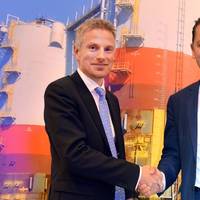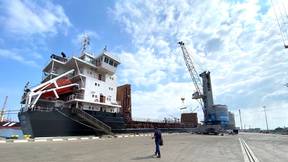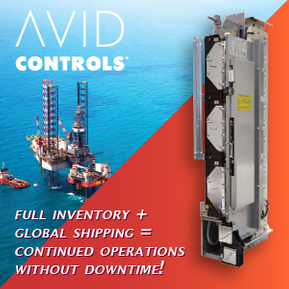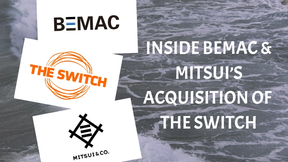DNV GL on Maritime Cyber Security
What are the best options for securing remote connections on ship and offshore systems? Which operational technology on board is most vulnerable to cyber-attacks? DNV GL has published a Recommended Practice (RP) on “Cyber Security Resilience Management” to help the industry address potential cyber hazards. Developed in cooperation with customers, the RP provides guidance on risk assessment, general improvements to cyber security, and the verification of security improvements and management systems. “With ships and mobile offshore units becoming increasingly reliant on software-dependent systems, cyber security is an important operational and safety issue for the maritime world…
First ISDS for DNV GL Classed Ocean Greatwhite
DNV GL has welcomed the world’s largest semi-submersible drilling rig into class recently. Ocean Greatwhite is 123 metres long and 78 metres wide and was delivered at Hyundai Heavy Industries in Ulsan, South Korea. Owned by the Houston-based drilling contractor Diamond Offshore, the rig will be chartered to oil major BP and will operate in the Great Australian Bight. Ocean Greatwhite is also the first new-build rig to receive the DNV GL Integrated Software Dependent Systems (ISDS) notation. ISDS are systems whose performance is dependent on the overall behaviour of their integrated software components. DNV GL’s ISDS standard helps owners and operators minimise software integration errors and delays in projects involving complex integrated systems.
Cyber Security In Shipping & Offshore Ops

Global shipping and offshore oil and gas operations are increasingly dependent on integrated networks, based on various software and data transfer solutions. Systems and equipment onboard are interconnected, monitored and controlled through an onboard automation network. Onboard systems are increasingly also connected ashore to the owners’ or technology providers’ control centers. Equipment manufacturers want to remotely upgrade the software of their systems and monitor their use to be able to optimize operations and to scheduled needed maintenance service.
DNV GL Sees Hybrid Propulsion, Connectivity as Hot Trends
Hybrid propulsion systems and connected ship solutions are emerging technologies that are gaining ground faster than expected, according to Tor E. Svensen, CEO DNV GL – Maritime, giving an update on the classification society's Shipping 2020 report. "While operational efficiency and emissions reductions are the main motivators behind these developments, the update shows that the future fuel mix will be much more diverse," Svensen said. Though LNG as a ship fuel was one of the standouts in the 2012 report, its prediction of up to 1,000 LNG-fueled vessels by 2020 will most likely not be met, due to continuing high investment costs and slower development of infrastructure. However, as more bunkering options come in place, growth could accelerate, he added.
DNV GL sees Hybrid Propulsion, Connectivity the Emerging Trends
With 2020 in sight, DNV GL looked at the lessons to be learned from the update to the classification society’s “Shipping 2020” report which was published in 2012. Now, three years later, hybrid propulsion systems and connected ship solutions are emerging technologies that are gaining ground faster than expected, outlined Tor E. Svensen, CEO DNV GL – Maritime, at the opening day of Nor-Shipping in Oslo. “While operational efficiency and emissions reductions are the main motivators behind these developments, the update shows that the future fuel mix will be much more diverse,” Svensen said. LNG as a ship fuel was one of the standouts from the last report…
DNV GL - Maritime CEO Addresses Cybersecurity at CMA 2015

“Ships and offshore structures are becoming more and more interconnected,” said Tor Svensen, CEO DNV GL - Maritime, when taking the stage at this year’s CMA (Connecticut Maritime Association) event in Stamford, CT. Cybersecurity in the maritime and offshore industry was also up for discussion at this year’s CMA Shipping event during a session with the US Coast Guard, ship owners and class representatives. In the past, critical network segments onboard vessels used to be kept isolated. This has changed. “This is a weak spot,” said Svensen.
Connectivity Lifts Safety and Efficiency to the Next Level
Ship classification society risk and sustainability service provider DNV GL briefed the press today on the future of shipping at an event at the Posidonia exhibition in Greece. Tor Svensen, CEO, DNV GL Maritime, examined the potential and the challenges of shipping’s increasing use of connected systems to improve safety and efficiency. This new paradigm requires a different approach to testing and certification, to ensure safety and reliability while retaining a level competitive playing field. Tor Svensen presented DNV GL’s recently released report: “The Future of Shipping”. The report maps out six pathways to a future for the industry which is safer and more sustainable: safe operations of ships…
DNV GL Acquires Marine Cybernetics

DNV GL, a ship and offshore classification society and technical risk service providers, has acquired Marine Cybernetics, a company for third-party testing of computer control systems. The acquisition expands DNV GL’s scope of services in the offshore and maritime industries. Marine Cybernetics was established in 2002 as a spin-off from the Norwegian University of Science and Technology (NTNU). Based in Trondheim, Norway, the company introduced the concept of Hardware-In-the Loop-Testing (HIL) to the maritime and offshore industries.
A New Revision of DNV's Offshore Standard for ISDS

A new version of DNV’s offshore standard for Integrated Software Dependent Systems (ISDS) has been issued. DNV is experiencing increasing demand from the drilling market for this kind of service and has now established a separate dedicated section in order to better serve this growing market. DNV’s offshore standard OS-D203 has been revised in order to clarify the requirements for assigning an ISDS class notation to an offshore unit as proof of compliance with the standard as well as to clarify the text in general and remove known inconsistencies.
Dolphin Drilling to Receive the First ISDS Class Notation
“With the diagnostics and remote access that is being built into our rigs now, it is really important that software integrity is flawless,” said CEO Ivar Brandvold of Fred. Olsen Energy ASA. “Our analysis indicates that applying the ISDS class notation can easily save USD 6-20 million by avoiding the delays caused by the need to re-work software,” said Rolf Benjamin Johansen, the director of operations at software integration for DNV maritime and energy. “In fact, this range is conservative as it does not include avoided costs. Being on schedule avoids propagating supply-chain costs and loss of brand reputation. The ISDS notation focuses on how to set up and run a project and how to develop quality assurance processes that will last throughout the vessel’s lifetime.







